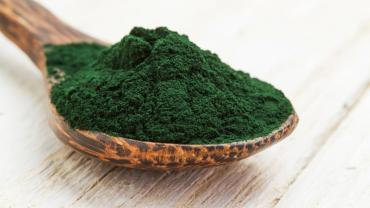
Spirulina.
The mere mentioning of the word brings to mind the bulk foods section in a health food store or co-op where this dark green powder stands out among the browns and beiges of brown rice buckwheat spelt and quinoa. Its bold emerald color is the visual expression of the extraordinary array of nutrients it holds. It’s a key ingredient in many greens powders and is included in some commercial kombuchas and other bottled drinks where the vibrant green almost automatically screams “healthy”! But what really is spirulina?
Spirulina is a cyanobacterium – a blue-green algae which is cultivated worldwide and used as a nutritional supplement for humans as well as in aquaculture and livestock farming. (It is often added to poultry feed to increase the nutrient content.) This is no surprise considering spirulina’s nutrient density. It’s loaded with iron copper manganese riboflavin and thiamin and has lower but still impressive amounts of niacin pantothenic acid magnesium potassium and other vitamins and minerals. There has been some controversy over whether algae is a suitable source of B12 for vegans. Some algal species do produce B12; however not all of these are true B12. Chlorella organisms produce true B12 but spirulina produces a pseudo-B12 which researchers have determined is an inactive compound and therefore not appropriate for maintaining healthy B12 status in individuals who avoid animal products entirely.
Spirulina may be lacking in B12 but surprisingly it’s a complete protein. It contains all the essential amino acids though it has relatively low concentrations of lysine and the sulfur amino acids (methionine and cysteine). For a food not from the animal kingdom spirulina’s total protein density is fairly impressive: one ounce of dried spirulina contains 16 grams of protein. That is something! However being realistic it’s a very rare person who could consume a whole ounce of spirulina in one sitting. Even if someone wanted to eating algae in that quantity on a regular basis would be cost prohibitive. So spirulina isn’t exactly the most efficient way to meet your protein needs but it can certainly make an occasional contribution.
Because spirulina is expensive—but super-concentrated when it comes to nutrients—small amounts can be effective when taken as nutritional supplements in the form of capsules tablets or when the powder is added to smoothies shakes or baked goods. (You can even use it in hummus!)
Okay so minus the B12 spirulina seems almost too good to be true. But what does it actually do? Well a quick perusal of the scientific literature says: just about everything! One study says owing to its “apparent ability to stimulate whole human physiology Spirulina exhibits therapeutic functions such as antioxidant anti-bacterial antiviral anticancer anti-inflammatory anti-allergic and anti-diabetic” functions. Not bad for algae. It may also be helpful for the immune system as it has been shown to increase phagocytic activity of macrophages stimulate the production of antibodies increase accumulation of natural killer (NK) cells and activate and mobilize T and B cells. Owing to some of these influences on immune processes spirulina has been studied as an adjunct to conventional cancer treatments.
Spirulina may be helpful for cardiovascular health and for individuals with type 2 diabetes. And considering the vascular effects of hyperinsulinemia and elevated blood glucose these two are inextricably linked. A meta-analysis determined that spirulina reduces total cholesterol and LDL while raising HDL-C. Other studies have similar findings. Spirulina is also a potent antioxidant. It’s a rich source of superoxide dismutase (SOD) increases the activity of endogenous SOD and catalase and inhibits lipid peroxidation and DNA damage. The antioxidant function may help protect diabetics from nephropathy resulting from excess oxidative stress as has been demonstrated in mouse models. And spirulina’s beneficial effects for type 2 diabetics go beyond this. Supplementation with spirulina at 2g/day for two months resulted in significant reductions in fasting blood glucose HbA1c triglycerides and apolipoprotein B with a small increase in HDL-C and reduction in total cholesterol creating a more favorable overall cardiovascular risk profile with improved TC:HDL and triglyceride:HDL ratios. And remember we’re talking about algae. Algae! Who knew? It’s true though: this green stuff that you might otherwise scrape off the bottom of your canoe really is a bit of a powerhouse.